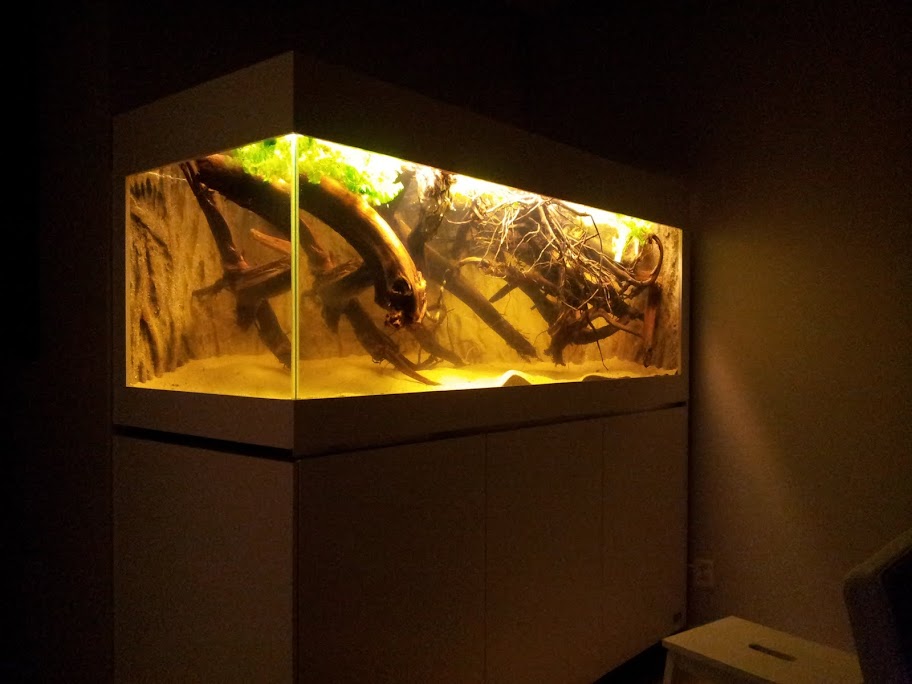Jacco
Member
- Messages
- 45
I started an 'amazone aquarium' 3 months ago. Here are some numbers:
1.70 long, 0.7 wide, 60 high.
JBL 1500e filter (pumping around 800 l/h)
50 liters of filter sand (0.5 - 0.9 mm)
filled with osmosis water.
everyday 30 liters are changed (automaticly)
temperature around 27 C
pH 6
kH 1
Here a pic (more than a thousand words)

a nice look at an empty aquarium, wood 'wattering in' and my own created background.
Here the same but 10 weeks later (cannot see my background anymore... )
)

I only have a simple camera... so no pic's of the fish.
What I've got so far:
30 parachareidon simulans (wild)
20 hyphessobrycon amandae (f1)
2 microgeophagus ramirezi (wild)
4 rubrocaudatus (wild) (was a group of 18... haven't figured out why i lost them and other fish stayed oke...)
some corydoras sterbai which came as eggs with plants from a friend. (somebody have a trick to get them out easily?)
And I want to keep a group (2-3m 4-5 f) of A.bitaeniata (rio Tigre). An importer with connections in peru is currently making inquieries if he can get somebody up there to catch some... keeping my fingers crossed.
Plants... not realy my interst, but at the moment I'm still starting up and i keep more variaties than I will end with. 50-75% is coverd with floaters (this will stay), but I'm waiting for my echinodorus to grow, so I can remove some other plants.
I still want to play with the placement of the wood. So I haven't added any leaves yet (beech, oak etc.)
My dilemma's:
My current (luxary) dilemma, I've found some beautiful dicrossus maculatus (wild). And am wondering in what ratio (male:female) to keep them and if 2 males would keep each other alife. Is 2m 3f a livable group?
the pH of my aquarium, eventhough i've got it file with osmosis water I have trouble to get it to around 5. Peat doesn't do the trick (unless i use 50 liters of it maybe and where to place it...) I used some acid (H2PO4) for the time being, but would like to use something beter. Any suggestions?
Well this is it so far, looking forward to your comments.
1.70 long, 0.7 wide, 60 high.
JBL 1500e filter (pumping around 800 l/h)
50 liters of filter sand (0.5 - 0.9 mm)
filled with osmosis water.
everyday 30 liters are changed (automaticly)
temperature around 27 C
pH 6
kH 1
Here a pic (more than a thousand words)

a nice look at an empty aquarium, wood 'wattering in' and my own created background.
Here the same but 10 weeks later (cannot see my background anymore...

I only have a simple camera... so no pic's of the fish.
What I've got so far:
30 parachareidon simulans (wild)
20 hyphessobrycon amandae (f1)
2 microgeophagus ramirezi (wild)
4 rubrocaudatus (wild) (was a group of 18... haven't figured out why i lost them and other fish stayed oke...)
some corydoras sterbai which came as eggs with plants from a friend. (somebody have a trick to get them out easily?)
And I want to keep a group (2-3m 4-5 f) of A.bitaeniata (rio Tigre). An importer with connections in peru is currently making inquieries if he can get somebody up there to catch some... keeping my fingers crossed.
Plants... not realy my interst, but at the moment I'm still starting up and i keep more variaties than I will end with. 50-75% is coverd with floaters (this will stay), but I'm waiting for my echinodorus to grow, so I can remove some other plants.
I still want to play with the placement of the wood. So I haven't added any leaves yet (beech, oak etc.)
My dilemma's:
My current (luxary) dilemma, I've found some beautiful dicrossus maculatus (wild). And am wondering in what ratio (male:female) to keep them and if 2 males would keep each other alife. Is 2m 3f a livable group?
the pH of my aquarium, eventhough i've got it file with osmosis water I have trouble to get it to around 5. Peat doesn't do the trick (unless i use 50 liters of it maybe and where to place it...) I used some acid (H2PO4) for the time being, but would like to use something beter. Any suggestions?
Well this is it so far, looking forward to your comments.
